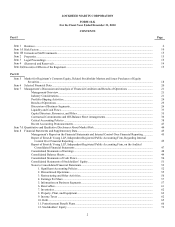Lockheed Martin 2010 Annual Report Download - page 20
Download and view the complete annual report
Please find page 20 of the 2010 Lockheed Martin annual report below. You can navigate through the pages in the report by either clicking on the pages listed below, or by using the keyword search tool below to find specific information within the annual report.12
International sales may pose different risks.
In 2010, our sales to foreign governments (including foreign military sales funded, in whole or in part, by the U.S. Government)
were 15% of net sales. As a company, we have a goal to grow international sales over the next several years. Our international
business may pose risks that are different, and potentially greater, than those encountered in our domestic business due to the potential
for greater volatility in foreign economic and political environments. International procurement rules and regulations, contract laws
and regulations, and contractual terms are different from those in the United States, and may be interpreted differently by foreign
courts. Our international business is highly sensitive to changes in foreign national priorities and government budgets, and may be
further affected by global economic conditions and fluctuations in foreign currency exchange rates. Sales of military products are
affected by defense budgets (both in the U.S. and abroad) and U.S. foreign policy.
Sales of our products and services internationally are subject to U.S. and local government regulations and procurement policies
and practices including regulations relating to import-export control. Violations of export control rules could result in suspension of
our ability to export items from one or more business units or the entire Corporation. Depending on the scope of the suspension, this
could have a material effect on our ability to perform certain international contracts. There also are U.S. and international regulations
relating to investments, exchange controls, taxation, and repatriation of earnings, as well as currency, political, and economic risks.
We also frequently team with international subcontractors and suppliers who are exposed to similar risks.
In international sales, we face substantial competition from both domestic manufacturers and foreign manufacturers whose
governments sometimes provide research and development assistance, marketing subsidies, and other assistance for their products.
Some international customers require contractors to comply with industrial cooperation regulations and enter into industrial
cooperation agreements, sometimes referred to as offset agreements. Offset agreements may require in-country purchases,
manufacturing, and financial support projects as a condition to obtaining orders or other arrangements. Offset agreements generally
extend over several years and may provide for penalties in the event we fail to perform in accordance with offset requirements. See
“Contractual Commitments and Off-Balance Sheet Arrangements” in Management’s Discussion and Analysis of Financial Condition
and Results of Operations beginning on page 39 of this Form 10-K.
Our business involves significant risks and uncertainties that may not be covered by indemnity or insurance.
A significant portion of our business relates to designing, developing, and manufacturing advanced defense and technology
systems and products. New technologies may be untested or unproven. Failure of some of these products and services could result in
extensive loss of life or property damage. Accordingly, we also may incur liabilities that are unique to our products and services,
including combat and air mobility aircraft, missile and space systems, command and control systems, air traffic control management
systems, cyber security, homeland security, and training programs. In some, but not all circumstances, we may be entitled to certain
legal protections or indemnifications from our customers, either through contractual provisions, qualification of our products and
services by the Department of Homeland Security under the SAFETY Act provisions of the Homeland Security Act of 2002, or
otherwise. The amount of insurance coverage that we maintain may not be adequate to cover all claims or liabilities, and it is not
possible to obtain insurance to protect against all operational risks and liabilities.
Substantial claims resulting from an accident, failure of our product or service, or other incident, or liability arising from our
products and services in excess of any indemnity and our insurance coverage (for which indemnity or insurance is not available or not
obtained) could harm our financial condition, cash flows, or operating results. Any accident, even if fully indemnified or insured,
could negatively affect our reputation among our customers and the public, and make it more difficult for us to compete effectively. It
also could affect the cost and availability of adequate insurance in the future.
Our earnings and margins may vary based on the mix of our contracts and programs, our performance, and our ability to
control costs.
Our earnings and margins may vary materially depending on the types of long-term government contracts undertaken, the nature
of the products produced or services performed under those contracts, the costs incurred in performing the work, the achievement of
other performance objectives, and the stage of performance at which the right to receive fees is finally determined (particularly under
award and incentive fee contracts). Changes in procurement policy favoring new, accelerated, or more incentive-based fee
arrangements or different award fee criteria may affect the predictability of our profit rates.
Our backlog includes a variety of contract types which are intended to address changing risk and reward profiles as a program
matures. Contract types include cost-reimbursable, fixed-price incentive, fixed-price, and time-and-materials contracts. Contracts for
development programs that have complex design and technical challenges are typically cost-reimbursable. Under cost-reimbursable
contracts, we are reimbursed for allowable costs and paid a fee, which may be fixed or performance-based. In these cases, the
associated financial risks primarily relate to a reduction in fees, and the program could be cancelled if cost, schedule, or technical
performance issues arise.
























